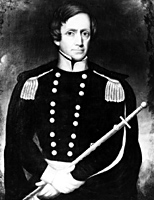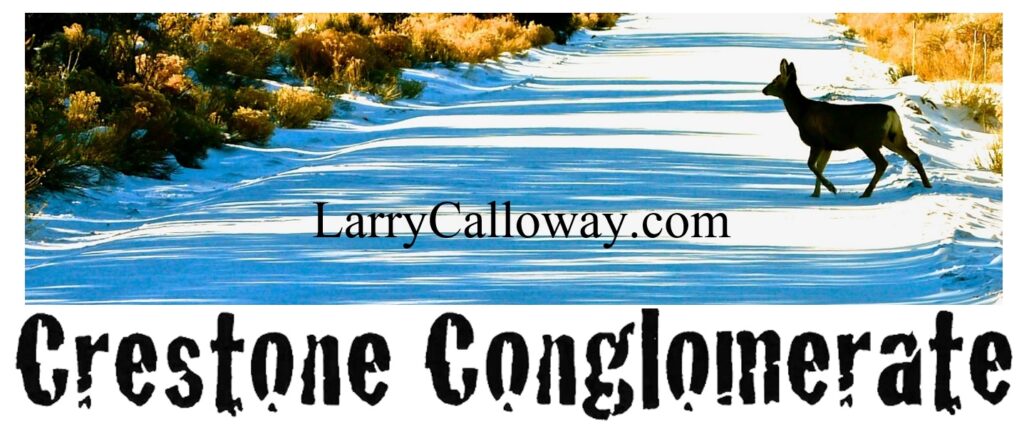
It was Indian Market Sunday in Santa Fe. One of the sisters — Stephanie or Susanna, I don’t remember who — carried a bottle of champagne in a brown bag. They were slim and poised in their bright summer dresses. We met at the Albuquerque Journal building, where I had my office, and walked four blocks to the plaza. The streets were full of money and Native American art. At the plaza they were going to meet another sister, Adelia, and her two children. They hated to cause a scene, but this thing was a long time coming. It was August 18, 1996. One hundred fifty years ago to the day their great-great grandfather, Gen. Stephen Watts Kearny, led his Army of the West into the Santa Fe plaza and declared New Mexico a possession of the United States.
Historian Bernard de Voto, relying on journals, letters and official reports, imagined the event this way: “Bridles jingled and scabbards clanked in the little, twisting, dirty streets, between the brown adobe houses. The infantry stood at parade rest, the tired horses drooped, in the silence one heard the rustle of cottonwoods and the silver music of the creek. The ranks stiffened and the muskets came to present arms, Kearny and his staff raised their sabers, the bugles blared down those empty streets, and the flag went up. As it touched the top of the staff, the artillery on the hilltop boomed its salute, and for the first time in history the Americans had conquered a foreign capital.”
Concerning the people, De Voto remarked, “There is no record of what they felt.” But someone must have made note of a whimper somewhere; for De Voto describes “a low wailing behind shuttered windows where women cowered in terror,” and Paul Horgan mentions “sounds of grief within some of the houses.” The fear was not justified. These were disciplined soldiers under compassionate marching orders. The postcolonial political grievance is not about the counterpoint of bugles and centuries of silvery music. It is about empire. For the first time, as de Voto remarked, the United States conquered a foreign capital. It was in the name of democracy and under the color of destiny.
Manifest destiny: the belief expounded by President James K. Polk and the new mass-circulation newspapers that American expansion throughout the hemisphere was pre-arranged in heaven. Expansionist editors also promoted the false idea, as historian Frederick Merk put it, that the people who were about to be absorbed were “panting for annexation.” Polk persuaded Congress to declare war on Mexico — a part of the Polk precedent that would be ignored by later presidents attacking foreign capitals.
Kearny’s orders from the secretary of war, William L. Marcy, were to “act in such a manner as best to conciliate the inhabitants, and render them friendly to the United States.” Historian Frederick Merk says, “These instructions were carried out well.” In Santa Fe Kearny issued a proclamation assuring freedom of worship, peaceful possession of property and protection against hostile Indians. In six weeks under his command, a liberal set of laws that is still compiled in the statue books under the title “The Kearny Code” was imposed and construction of Fort Marcy was begun on the hill overlooking Santa Fe.
And now it was the 150th anniversary of the biggest thing ever to come down the Santa Fe Trail: the United States of America. But nothing was planned, not one proclamation, not one small firecracker. New Mexico and Santa Fe officially ignored the anniversary, and the snub was no oversight — not in a city that annually celebrates the entrada of Don Diego de Vargas and has a statue of Juan de Onate.
“I’m not sure you’ll find too many people in New Mexico who want to celebrate the occasion,” Historical Society of New Mexico president Robert J. Torrez, who also was the state historian, told me beforehand. “It was an invasion. The occupation was an act of war.” Torres said the call for papers to be delivered at the annual Society conference included the broad subject of the Mexican-American War but there was no response. The war was one of the most important events of the 19th Century, he said, “but only recently have we been looking at the Mexican side of it. It’s not necessarily a pretty picture of American foreign policy at the time.”
Didn’t Kearny deserve some recognition for non-violence, fairness and the Kearny Code? The state historian said the general might have been even-handed, but the conquest of New Mexico turned bloody after he marched on to California. The state historian delivered a paper on this “Revolt of 1847” at a conference sponsored chiefly by the Dona Ana County Historical Society on March 30 on the events of 1846, “New Mexico’s Year of Destiny.” It was the only organized event I knew of that directly attacked the politically controversial anniversary. Torrez said his paper was well received and that a lot of historians thought it was about time someone told the Mexican side.
Torrez’ main legal argument against Kearny was that he exceeded his authority in declaring all New Mexicans to be U.S. citizens. Future rebels, therefore, could be tried for treason and executed. But they weren’t citizens yet, he maintained. “The history books still consider them traitors. We need to reevaluate whether these men were Mexican patriots.”
The historian emphasized the events of Jan. 19, 1847, and their consequences. Kearny was long gone when a group of armed men attacked the home of appointed territorial Gov. Charles Bent in Taos, killing him and six other U.S. officials. “Within two days, the uprising had spread through much of northern New Mexico,” Torrez found.
Stephan Watts Kearny
It was put down by U.S. soldiers using heavy artillery, and on Feb. 1, “the Americans proceeded to raze Mora to the ground.” On Feb. 3-4, they attacked Taos Pueblo, killing perhaps 150 to 200 New Mexicans and their pueblo allies, many of whom had taken refuge within the thick adobe walls of the pueblo church. On Feb. 7, after a short trial, a leader of the Taos uprising was hanged in the plaza, and later trials resulted in 21 public hangings in the next six months, Torrez found. On July 6, 1847, a detachment of Americans took 40 men prisoner at the community of Los Valles, 20 miles south of Las Vegas, after the bodies of an American officer and two infantry men were found nearby. The village was destroyed, and a trial in Santa Fe resulted in six public hangings on Aug. 3.
“Capital punishment was certainly not unknown in New Mexico during the Spanish colonial and Mexican periods,” wrote Torrez, “but this harsh introduction to American jurisprudence seems to have lingered in the memory of New Mexicans.” As a result, he reasoned, northern New Mexico juries seldom returned death penalty verdicts during Territorial days. (Nor do they now.) “We know little of the motives of the men who decided to take up arms against the Americanos in 1847. So far the documentation shows only that many suffered terribly for having done so,” Torrez wrote.
The Kearny sisters grew up knowing some important streets in San Francisco and Denver and a town in Nebraska were named after their great-great grandfather. The grew up seeing the name misspelled, as it often is in Santa Fe, and mispronounced — kerr-knee instead of car-knee. It was particularly frustrating to Stephanie, named for him, that the general had fallen into disrepute. He was a good soldier and a good man, but that did not seem to matter.
De Voto, a Kearny fan, wrote in 1943 that the general and his officers “brought more safety, stability and hope to New Mexicans in two months than Spain had found for them in two centuries, or Mexico after Spain.” He also wrote, “In the vaudeville show of swollen egoism, vanity, treachery, incompetence, rhetoric, stupidity, and electioneering which the general officers during the Mexican War display to the pensive mind, Kearny stands out as a gentleman, a soldier, a commander, a diplomat, a statesman, and a master of his job.” And again: “Kearny’s service to the United States at a decisive turning point in history is great and was itself decisive. He did the jobs assigned to him, quietly, completely, authoritatively. He took New Mexico and organized it.”
Kearny’s swift decline began in California. Learning from Kit Carson that other American forces had conquered the West Coast and misled by the New Mexico passivity, Kearny left Santa Fe with only 100 cavalrymen. Approaching San Diego in early December, they were surprised by a fierce group of Californios in a fight that left about 21 of Kearny’s men dead and 23 wounded. Next the general’s authority was defied by Col. John C. Fremont, the self-promoting “pathfinder” of the West who was married to the daughter of a powerful politician, Sen. Thomas Hart Benton, D-Mo. After setting up the territorial government in California, Kearny went to Washington, D.C., where he caused Fremont to be found guilty of insubordination in court-martial. But in the process Benton put Kearny on trial and sullied his reputation. The general died 10 months later, in November 1848, of yellow fever contracted in Mexico.
Cresson Kearny, a Princeton-trained engineer and geologist who settled in Montrose, Colo., was the most direct descendant of the general. He and his wife had a son and four daughters. The daughters all migrated one by one to Albuquerque. And on that Indian Market Sunday three of the sisters were celebrating alone — except for the company of a German publisher named Hans von Sachsen, the historians Mark L. Gardner and Marc Simmons, and me.
In the morning I had accompanied Gardner and Simmons to Ca¤oncito in Apache Canyon, near Santa Fe, where they read the testimony of soldiers, as Simmons put it, “to the wind.” A local man in a big pickup drove up beside the two Anglo historians as they stood beside the historical marker that says, “This is where Gov. Manuel Armijo prepared to defend New Mexico against the American Army in 1846.” They were orienting a copy of a 150-year-old map — a document newly discovered by Gardner — that showed Armijo’s aborted defense preparations. The driver leaned out his window and yelled: “Go home!” As the truck roared off, Simmons expressed delight. “That adds to it,” he said.
On the plaza, the Kearny sisters took their champagne in the brown bag to the low stone pedestal that bears the name of Stephen Watts Kearny. Simmons pulled an old red, white and blue streamer from his pocket. Pictures were taken. Susanna Kearny read aloud from a photocopy of her great-great grandfather’s handwritten journal. Champagne was sipped from plastic cups. The streamer was draped on the stone. And that was it. The 150th birthday of the American Southwest. Nobody paid much attention. As the Kearny sisters left, a fat sweat-streaked man with a giant-size cup of ice and cola sat on the monument.
